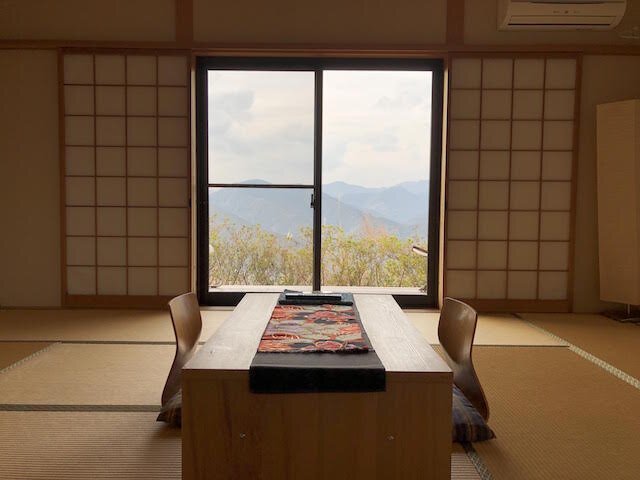Hiking Japan’s Kumano Kodo trail
Looking for a way to explore Japan that is off the beaten path? On this trail, you won’t find your typical tourist crowd.
What is the Kumano Kodo?
The Kumano Kodo is an ancient pilgrimage route, now a UNESCO world heritage site, for those who practice the Japanese religion of Shinto (an ancient religion rooted in nature worship). Starting in the 9th century, emperors and imperial families would follow this route, and by the 14th century, commoners like you and me as well as samurai warriors would hike it too! The forested landscape of this trail takes you through sacred mountains and past streams, rivers, waterfalls, and shrines. This area of the Kii Peninsula is thought to be a place of rebirth. These days, tourists from all walks of life are welcome to enjoy the magical journey.
Why hike the Kumano Kodo?
Japan has a lot to offer, and while most tourists hang out in the big, crowded cities of Tokyo and Kyoto, there is actually a ton of nature and rural beauty to enjoy in this amazing country. The Kumano Kodo offers natural beauty, escape from the crowds, a chance to encounter Japanese locals outside of the tourist centers, and experience a piece of history.
Plus, the Kumano Kodo is actually backpacking ‘lite’. That’s because even though you might hike between sections, you can spend the night inside warm, comfortable ryokan (traditional Japanese hotels). You can shower, relax your muscles in an onsen (a Japanese hot tub) and enjoy home cooked delicious food provided by the ryokan (usually included in the price of the stay!). With accommodation, breakfast, and dinner provided for you, all you really have to bring with you is the clothes on your back and some snacks/food for lunch (we bought onigiri and snacked on it, which can be found in any 7/11 in Japan!). We travelled our 2 weeks in Japan with our backpacking bags and hiked with that every day (less than 30 lbs) but if you don’t want to carry everything you bring with you, there are courier services that will pick up your bags in one place and deliver them to you in another.
Where is the trail and how do I get there?
Most people start the trail in Takijiri-oji. To do the full trail, it takes about a week and is around 80 kilometers. However, you can break up the journey any way you like seeing as the trail follows highways and train routes that allow you to essentially hop on, hop off.
You can access the beginning of the trail via a train from Osaka to Kii-Tanabe followed by a bus from Kii-Tanabe to Takijiri. At the end of the trail, you can take a bus to Kii-Katsuura and then take a train from there to Tokyo and beyond. Check time tables for Japan’s famous trains! Also, the train stations themselves can offer special experiences, like the foot bath onsens in Kii-Katsuura.

You need to make reservations in advance to stay at many of the ryokan along the route, so visit this main site to get started and to get booking!
What do I bring?
I have a roundup of my go-to backpacking gear here, or you can check out my day hiking list. Never forget your 10 essentials to recreate safely outdoors!
Below is a map of all the main areas referenced in the post below, and here’s an overview of the trail elevation and other details.
My experience: 4 days, 3 nights along the Kumano Kodo (Nakahechi route)
Day 1: Takijiri-oji to Takahara, night in Takahara (approximately 4 km)
You start your journey at the visitor center in Takijiri-oji, which sells some goods and has a restroom, as well as maps and other historical information about the hike.




From here, its an upward hike that then evens out and takes about 2 hours to arrive at the first ryokan along the journey: Kiri-no-sato Takahara Lodge. Enjoy soaking in the onsen, sleep comfortable on traditional tatami mats, and enjoy incredible washoku meals.




Day 2: Takahara to Nonaka Tsugizakura-oji, night in Nonaka Tsugizakura-oji (approximately 13 km)
On day 2, we did a full 8 hours of hiking, mostly in dense forest with bamboo as well as past a large number of shrines.

We ended the day at a quaint, family run BnB Ryokan called MUI. The owners moved out of the big city (Tokyo) to start a quieter life in the country, raising their family, cooking for guests, and keeping goats in their yard!



Day 3: Nonaka Tsugizakura-oji to Hongu, day in Hongu and Yuomine, night in Hongu (approximately 21 km)
On day 3, we took a bus to Hongu. From there, we visited the famous shrines in the area including the famous Kumano Hongu Taisha, one of the most significant temples on the hike. We also visited what is supposed to be the largest torii gates anywhere at Oyunohara.




Later in the day we hiked to Yuomine (approximately 2.2 km one way), which is an incredibly special place on the pilgrimage. A historical hot spring village, the area is legandary for purification and healing. Hongu is the first of the 3 main temples one encounters on this journey. You can take a local bus back from Yuomine to Hongu. We spent the night at Blue Sky Guesthouse.

Day 4: Hongu to Kumano Nachi Taisha, then onward to Tokyo for the night
We actually didn’t hike on the 4th day – it was pouring rain and we wanted to get to see the Nachi Taisha temple and waterfall before heading back to Tokyo, so we cheated and took a bus from Hongu to Nachi Taisha, then from Nachi Taisha to Kii-Katsuura and back to civilization. To be honest, it actually took 3 small local buses to get to Nachi! So be warned this isn’t a direct travel and to build in extra time (I recommend spending the night near Nachi before going elsewhere).







